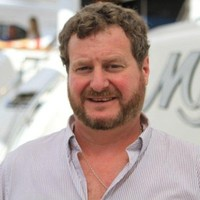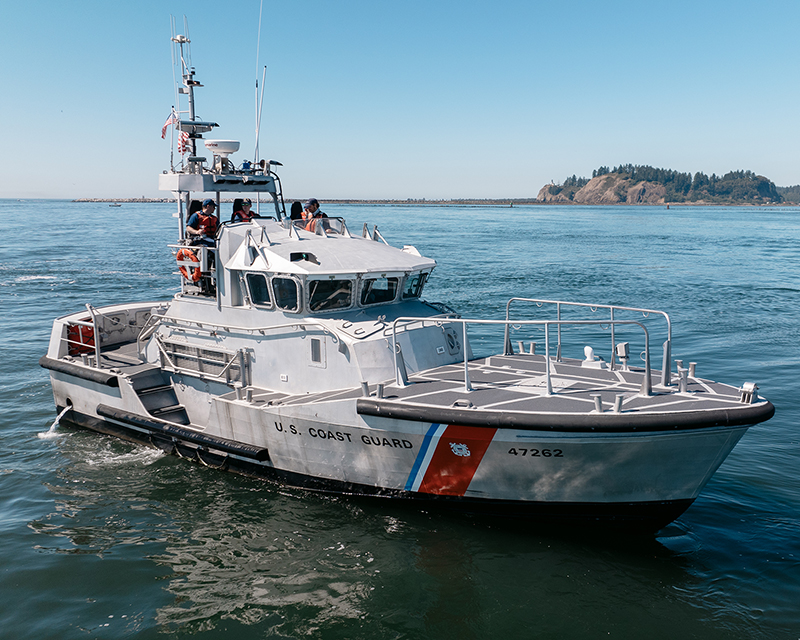Part of the Coast Guard’s mission is to assist mariners when things go wrong. Rescues in dire situations require specialized equipment, procedures, and training. To meet the mission readiness required for these dangerous circumstances, the USCG needs to practice in areas with extreme conditions.
That is precisely why the National Motor Lifeboat School (NMLBS) was created in 1968. The Coast Guard identified a need to create a standard of operations for the lifeboat community that required a practice area that could expose their men to all types of conditions. They created the school in Ilwaco, Wash., at the mouth of the Columbia River primarily because this area has a wide variety of training zones and the severe conditions needed to test the equipment and the mettle of their operators, who are seeking to become certified as surfmen.
“Our goal is to create the best possible boat operators in the Coast Guard by exposing them to the worst conditions,” said BMCS Senior Chief Trevor Armstrong, executive petty officer.
Known as the “graveyard of the Pacific,” the Columbia River bar presents unique qualities that create some of the most treacherous marine environments available.
The Columbia stretches from the Washington-Oregon border 1,243 miles to its headwaters in Canada. River volumes vary by season, but at the mouth of the river the Columbia delivers into the Pacific Ocean an average flow of 265,000 cu.ft. Per second (about 2 million gallons). The mouth of the river stretches 3.5 miles wide between the heads, and the main channel is a mile wide. The debris-strewn delta pushes sediments five miles into the ocean before it drops into the 1,500'-plus depths of the Astoria Canyon. Tides along Cape Disappointment typically run around 6', and tidal flows reach 80 miles upriver to the Willamette junction near Portland, Ore., and beyond. Currents at the mouth can run 5 knots when the tide flows in the same direction as the river. When this huge volume of water meets Pacific swells rolling up on the river delta’s shoals, the effects can be astounding.
Crossing the bar, even in mild conditions, can be challenging, and for hundreds of years, ships of all sizes have foundered there. The river’s unique geography and the adverse conditions it presents creates an ideal proving ground for the Coast Guard to train their personnel in a real-world setting.
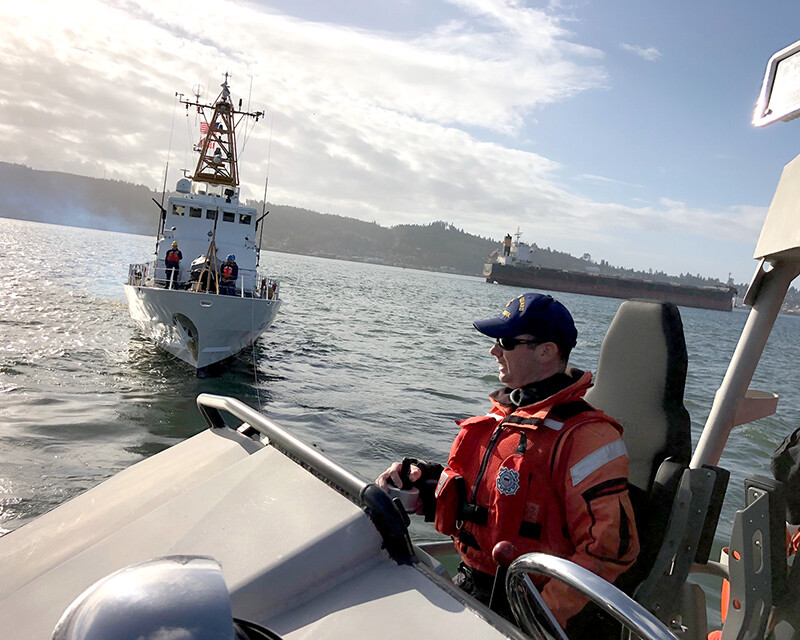
COURSE WORK
The school runs three different tiers of courses — basic operator, heavy weather, and the surf course. Each course is four weeks long and typically consists of 12 students. The courses include some classroom work but are primarily focused on hands-on operation and training using four of the six 47' Motor Lifeboats stationed at the school. They place three students on each boat, along with an instructor, an engineer, and a crewman.
The basic course is designed to get as many people as possible exposed to the area and teach them fundamentals. “The basic operator is a course to learn fundamentals. We’re not looking to get them in bad weather,” said Armstrong. “We just want them to get the essential skills and learn how to drive the boats.”
In the heavy weather course, students learn to operate in big swells and heavy winds. Students must already be at a designated heavy weather unit or a surf unit to get orders to take the course, and they have to be a boat driver who is desiring to go in the heavy weather or surf. “We’re looking for all the way up to 20-foot swells and 50 knots of wind which we want to expose them to as much as we can,” said Armstrong. “We’re trying to get the students in the worst weather possible to expose them to the fundamentals and operating life in these conditions. We go over how to tow boats, how to approach a vessel, how to pass dewatering pumps and other gear, how to pick people out of the water, and other essential operational tasks.”
Then there is the surf course, which is a very important course for the Coast Guard as it trains surfmen needed to operate in the most extreme conditions. There are usually only one or two surf courses per year. “We get students directly into breaking surf and show them techniques and the foundations of driving in breaking waters.”
For the surf course, students have to be at a designated surf unit and have passed the basic and heavy weather courses. There are only 18 surf stations in the Coast Guard, most of which are on the West Coast.
The course alone doesn’t necessarily qualify them as surfmen. The students have to go back to the station where they’re attached and show their commanding officer that they’re capable and able to make appropriate decisions and have the confidence and skills to be surfmen.
It can take up to six years to qualify as a surfman after you first step on one of these boats. Students who qualify are issued a surfman check — a brass check. It’s got his or her surfman number on it. Every surfman who gets qualified receives a number and is entered in the surfman registry and is entitled to wear a pin to signify the importance of this qualification, considered a milestone in someone’s operating career.
The school at the mouth of the Columbia River is adjacent to the Coast Guard station there. According to Armstrong, the mission of the lifeboat school is purely for instructing, but it will operate search and rescue if necessary. “If a vessel is in distress and if we’re near the area, and we can affect the rescue, then we will operate in that manner,” he said.
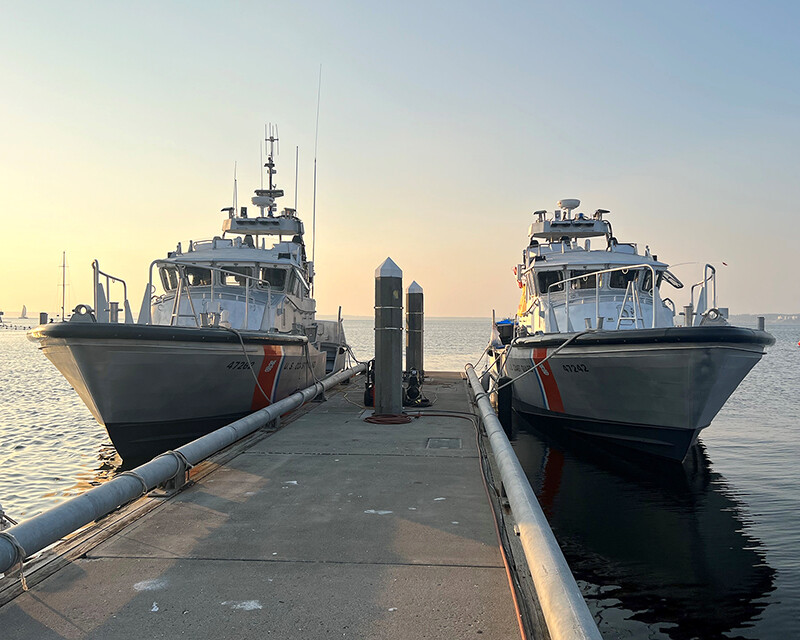
NEW LIFE
At the heart of the Surf School is the 47'11"x15' motor lifeboat. The vessels, which have a draft of 4'6", were originally built by New Orleans-based Textron Marine from 1997 until 2003. A total of 117 MLBs were placed in service on the Great Lakes and the northern areas of the East Coast and West Coast.
With thousands of rescues performed successfully even under some of the most-dire circumstances, the vessels have proven to be excellent surf boats. The lifeboats are rated to operate in 50 knots of wind, 30' seas and 20' surf. The “lifeboat” designation means they are designed to re-right even when knocked down or rolled 360°.
However, the all-aluminum vessels are nearing the end of their planned 25-year service life. The established track record and performance of the boats and the fact that many boats have hull and superstructures still in serviceable condition opened the door for an option. In the interest of mission readiness and cost savings, the Coast Guard decided to extend the service life of these vessels instead of having an all-new vessel engineered and built to replace them.
In 2019 the Coast Guard awarded Birdon America Inc. the contract to do the 47' Motor Lifeboat Service Life Extension Program (MLB-SLEP). In 2024, Birdon opened a new $5.5 million, 32-acre facility that includes a marina and boatyard in Portland, Conn., to support the project. The facility can handle seven boats at a time, and Birdon’s West Coast operations in Bellingham, Wash., can have five boats in production simultaneously.
“They arrive to us as a 47B [Bravo] and leave here as a 47C [Charlie],” Patrick Kinser, MLB program manager at Birdon, said. “We will do about 50 boats on the West Coast and about 60 boats on the East Coast from our two separate production facilities. We are doing the same boat at the same time on two different coasts to support the bicoastal delivery for the surf stations.”
According to the Coast Guard, the boats’ specifications are not changing. The Service Life Extension work is concentrated on preserving the performance of the MLB for an additional 20 years beyond the initial 25-year service life. To preserve the stability and self-righting capability, the contract limits the movement of the center of gravity and allows the use of ballast to maintain the center of gravity within allowed margins.
Major changes include the propulsion system — engines, reduction gears, shafts, rudders, skegs, and props — with equipment that is available now and will remain available for the next 20 years, replacement of the navigation system with the FLIR/Raymarine-provided Scalable Integrated Navigation System standardized across all Coast Guard boats, replacement of deteriorated forward deck and hull plate, and reconfiguration of the open bridge to provide shock-mitigating seats for the full crew with improved ergonomics.
“We essentially tear them down until there is really nothing left but for a few wires and some old insulation,” Kinser said. “There’s approximately 4,000 individual components that go on each boat, and it takes us just about six months to complete a boat in terms of delivery timeline.”
The new Cummins QSC 8.3, 530-hp turbo diesels are around 2,000 lbs. lighter than the old Detroit Diesel 6V92TA DDEC-IV, 435-hp engines they are replacing. Because of this, critical measures are taken to ensure the self-righting capabilities of the boats are not compromised. To ensure that the longitudinal, horizontal, and vertical centers of gravity are right where they need to be so that the boat can upright itself if it gets sideways in a wave, each boat is weighed on a special cradle prior to delivery.
“We’ve got a specially engineered ballast kit that goes in the boat and then we confirm that the weight and center of gravity is the same or similar to when the boat came in by putting it into a very precise measurement cradle that Birdon designed and built specifically for this project,” said Kinser.
According to the Coast Guard, the ballasting varies on each individual MLB with the amount and location determined through a post-SLEP inclining. Typically, approximately 1,250 lbs. of epoxy coated steel plate ballast is needed to maintain the center of gravity within the allowable margins.
Modern components provide additional safety features for the crew, and for the boat in terms of operation of the engines and the mechanical components, should the boat roll over. There’s a lot of engineering that goes into this, and once the vessels have been updated a significant amount of testing of all the new systems gets done. This includes, on-the-water testing of the boat to make sure it meets specifications prior to the delivery.
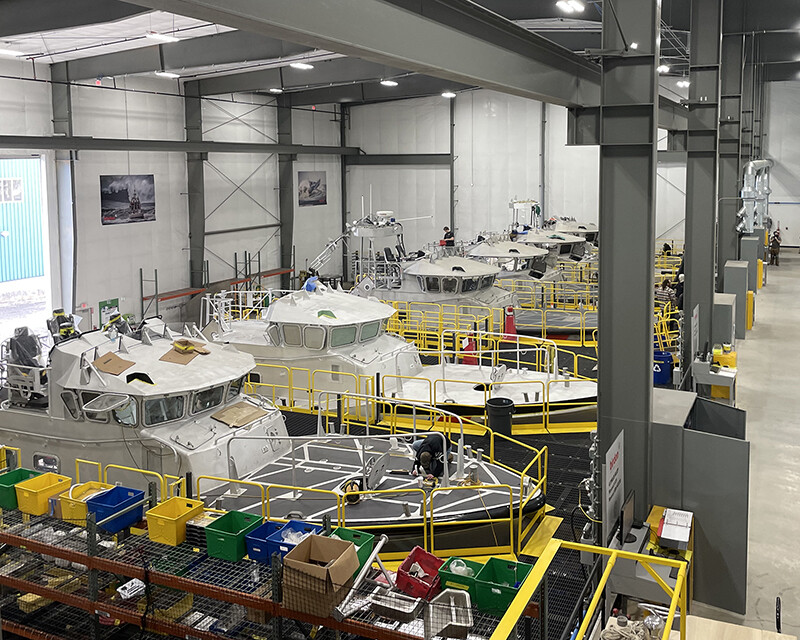
“We do extensive testing on the Charlies (47Cs) brackets for about a month in what we call phase six where we do in-plant tests, then dockside tests, and finally we do open-water builder’s trial testing,” said Kinser.
All of the MLBs at the National Motor Lifeboat School are 47Cs, and several other stations have received their upgraded boats as well. As WorkBoat went to press, Birdon said it has delivered 21 boats so far and expects to deliver another six boats before the end of 2024.
The original cost of each 47B MLB at delivery was approximately $1.2 million with a designed service life of 25 years. The total investment to convert each boat to a 47C and add an additional 20 years of service life is approximately $2 million per MLB. The actual cost will vary depending on the boat’s condition when it is sent to the shipyard for refit.
The biggest variable that affects costs is the hull condition. Plate renewal can vary from 10 sq. ft. for an MLB that has been in the Great Lakes to over 200 sq. ft. for some of the older MLBs that have been in saltwater environments. Even for the vessels that require additional plate renewal, the cost savings of the SLEP is substantial when compared to what it would cost to engineer, test and produce an all-new surfboat.



